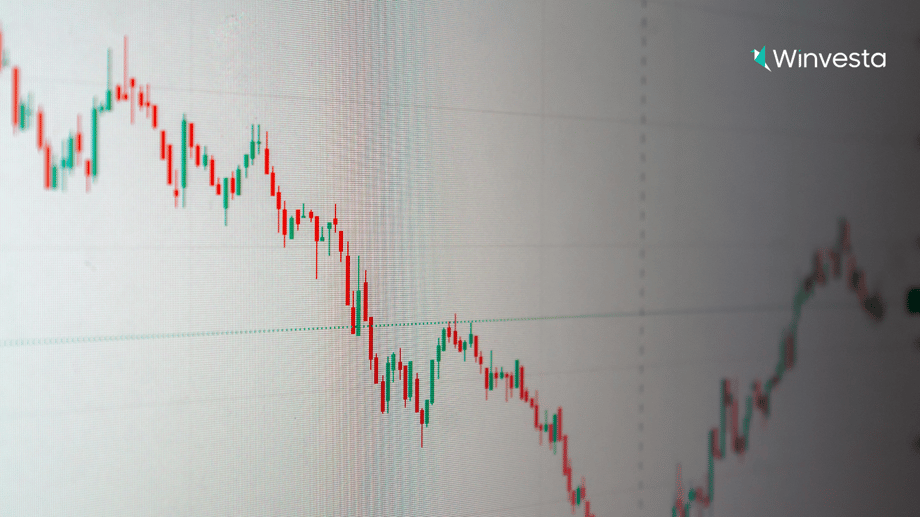Contents
US healthcare stocks: 2025 outlook
7 minutes read
14 July 2025

Healthcare in the US is heading into a period of rapid change. With rising patient demand, ageing demographics, and ongoing cost pressures, 2025 could be a turning point for the sector. Add in new technologies—from telemedicine to AI diagnostics—and you've got the kind of backdrop that can shape the next wave of winners in the stock market.
But for investors, that also raises a valid question: which healthcare stocks have staying power? With so many players—from insurers to pharmaceutical giants to digital startups—it's not always clear where the real potential lies. Throw in shifting regulations, policy changes, and election-year uncertainty, and even seasoned investors may hesitate before making a move.
That's why it's more important than ever to track which US healthcare stocks are best positioned heading into 2025. In this blog, we'll look closely at healthcare stocks you should have on your radar—from major players like UnitedHealth Group and CVS Health to rising competitors in health-tech and biotech. We'll also explain how upcoming policy changes may impact UnitedHealth Group Inc. stock and others across the sector.
You'll learn why healthcare stocks tend to hold up well—especially when the market is shaky—and how demographic trends will likely keep the demand flowing. Lastly, we'll offer practical tips on the best times to invest, whether you're watching UHC stock or exploring new avenues. If you're thinking about healthcare as part of your 2025 investing strategy, this is for you.
Top US healthcare stocks to watch in 2025
UnitedHealth Group: A leader in managed care
If you're looking for stability, UnitedHealth Group remains a top pick in healthcare stocks. The company runs the largest private health insurer in the US, with more than 50 million members through its United Healthcare stock division. It also operates the Optum business, which delivers pharmacy services, analytics, and care delivery.
UnitedHealth's advantage comes from its scale. In 2023, it brought in over $370 billion in revenue. That kind of consistent top-line growth helps it absorb regulatory risk better than smaller rivals. The company pays a growing dividend and has posted strong returns even during broader market downturns, making it attractive for long-term investors.
If Medicare Advantage enrollment and value-based care continue to expand, expect UnitedHealthcare stock to stay in demand. Its diversified business model and deep provider network give it a strong edge into 2025 and beyond.
CVS Health: Expanding from pharmacy to full-service care
CVS Health has moved far beyond its retail pharmacy roots. With the addition of Aetna and recent expansion into primary care clinics like MinuteClinic and Oak Street Health, it's betting big on delivering care, not just dispensing prescriptions.
In 2024, CVS announced plans to close underperforming stores to focus more on health hubs and virtual care. Combined with substantial insurance revenues and membership growth, CVS Health stocks remain a solid play for investors seeking defensive growth through healthcare infrastructure.
This shift to integrated care services may help CVS compete directly with both insurers and telehealth providers. For investors, that means exposure to several trends in one stock: retail health, managed care, and primary medicine.
Other rising contenders in digital health and biotech
While large-cap names like UnitedHealth and CVS offer stability, smaller players are where you might see more growth. Companies like Teladoc continue to push virtual care adoption. Though its stock has been volatile, demand for telehealth remains above pre-2020 levels.
Biotech firms such as Moderna and Regeneron are also ones to watch. Their innovations around mRNA platforms and rare disease therapies could spark new revenue streams. For 2025, expect more focus on companies building AI-based diagnostics, home testing, or streamlining drug development.
Investors looking to balance large-cap reliability with growth potential may consider a blend of big insurers, pharmacy care providers, and emerging digital platforms. Next, we'll look at how policy changes could affect these positions going into 2025.
How regulation will shape healthcare stock performance in 2025
%20-%202025-07-14T131958.636.png?width=1600&height=900&name=Blog%20images%20(2)%20-%202025-07-14T131958.636.png)
Policy shifts under the current and expected administrations
Regulation is a double-edged sword when it comes to healthcare stocks. Federal and state policies directly impact pricing, reimbursement, and enrollment growth—key factors for investor value. Heading into 2025, the political landscape may shift again, depending on the outcomes of the presidential election and congressional balance.
In recent years, the Biden administration has aimed to control drug costs through the Inflation Reduction Act. Proposals for broader Medicare negotiation could impact pharma profits. Alternatively, if a Republican-led government takes over, market-friendly policies ease pressure on insurers and drugmakers.
UnitedHealth Group stock tends to weather political transitions better than most, but increased regulation could still hit margins. Investors should keep tabs on key policy announcements, especially heading into Q2 of 2025.
Medicare Advantage and value-based care opportunities
One regulatory tailwind for healthcare stocks is the continued growth of Medicare Advantage and the push toward value-based care. These trends benefit insurers like UnitedHealth Group Inc. stockholders, as companies are incentivised to improve patient outcomes and reduce unnecessary spending.
As of 2024, over 50% of Medicare beneficiaries are enrolled in Advantage plans. That number is expected to grow in 2025, especially in states offering new subsidies or provider partnerships. Companies that invest early in care coordination and in-home services may gain long-term share.
This shift also supports companies delivering data analytics and remote care, as regulatory bodies push for cost efficiency and improved access. Investors should watch for provider networks that align incentives with better outcomes.
Risks for insurers and pharma from price control measures
For every growth prospect, there's a risk. If the government expands price negotiation powers or pushes for a cap on prescription drug costs, pharma companies could face tighter margins. Stocks like Pfizer or AbbVie might react negatively to such headlines.
Private insurers aren't immune either. Greater scrutiny on premium hikes or coverage limits could pressure earnings. UnitedHealth Group Incorporated stock and other large insurers may need to adjust their forecasts if reforms are enacted mid-year.
In short, regulation can define the winners and losers in the healthcare space. That's why understanding both the policies and the companies adapting to them is critical. Next, let's examine why healthcare stocks still make sense for long-term investors in 2025.
Why healthcare stocks remain strong investment choices in 2025
Ageing population and chronic care growth
One of the most concrete reasons to invest in healthcare stocks is demographics. The US population is ageing fast—by 2030, all baby boomers will be over 65. This group typically generates higher demand for medical services, long-term care, and prescription medications.
With chronic conditions like diabetes and heart disease on the rise, healthcare providers and insurers stand to benefit. For example, companies like CVS Health are expanding chronic care programs linked to pharmacy services, nurse visits, and remote monitoring.
More patients mean more utilisation, which can translate into consistent revenue with managed care models. For investors, that means healthcare stocks are positioned for steady long-term growth, even when other sectors lag.
Technological advancements powering next-gen care
Healthcare isn't just about hospitals anymore. Telemedicine, AI diagnostics, and wearable health trackers are redefining how care is delivered. Companies that adapt quickly to these trends could see accelerated adoption and higher margins.
CVS Health stocks offer a real-world example. Their acquisition of Oak Street Health and investments in virtual care are transforming retail spaces into integrated clinics. This shift makes care more accessible while reducing costs.
Investors looking for solid positions in this space should also watch software providers, health data platforms, and diagnostic innovators. These aren't speculative plays—they're practical companies solving high-demand issues with tech-enabled care models.
Defensive qualities during economic downturns
Healthcare is one of the few sectors that hold up when the economy stumbles. People don't stop filling prescriptions or seeking treatment in a recession. That's one reason healthcare stocks tend to outperform in volatile markets.
Large-cap names like UnitedHealth and CVS maintain stable cash flow and pay regular dividends, making them attractive for risk-averse investors. Plus, government-backed programs like Medicare and Medicaid help keep demand insulated from market swings.
So while healthcare may face pressure from regulation, its built-in demand drivers and resilience to downturns offer a reliable hedge. Next, we'll look at when the best times are to invest based on market signals and policy movements.

Ready to own a piece of the world’s biggest brands?
- Invest in 4,000+ US stocks & ETFs
- Fractional investing
- Zero account opening fees
- Secure and seamless
Start investing in just 2 minutes!

Build your global portfolio.
.png)
Invest in companies you love, like Apple and Tesla.

Track, manage, and grow your investments.
Timing your investments in US healthcare stocks for maximum return
Best time to invest: pre-earnings or post-policy announcements?
Timing can be just as important as stock selection. Healthcare stocks often experience movement around quarterly earnings results and major policy decisions. If you're following names like UHC stock, watch for end-of-quarter earnings reports, typically released in January, April, July, and October. These updates can trigger short-term price shifts based on membership growth, medical cost ratios, and guidance outlooks.
Policy announcements also play a significant role, particularly in election years. For instance, if Medicare Advantage rules change or drug pricing caps are proposed, stocks like UnitedHealth or CVS may adjust in anticipation or response. Investors often move early, so being aware of upcoming healthcare policy proposals can offer a timing advantage.
- Buy near earnings dips if fundamentals remain strong
- Monitor Washington's healthcare agenda during election cycles
- Use short-term volatility around announcements to enter at better valuations
Long-term vs short-term ROI considerations
If you're investing with a one- to three-year horizon, focus on companies with stable profit margins and strong forward earnings guidance. For example, UHC stock has delivered compound annual returns above 15% over the past five years, despite market volatility.
That said, short-term gains can still occur around M&A news, drug approvals, or expanded reimbursement codes. However, long-term investing in healthcare pays off because demand typically grows steadily, not in bursts. Add to that dividends and buybacks, and the compounding potential is clear.
- Prioritise long-term value over short-term spikes
- Stick with financially sound leaders like UnitedHealth Group
- Hold through volatility unless fundamentals break down
Now that you understand how timing can impact your returns on stocks like UHC stock, it's essential to apply this knowledge when building your investment plan.
Your next step involves keeping a close eye on earnings reports, policy developments, and sector trends tied to major healthcare players. Follow companies like UnitedHealth Group and CVS Health to spot smart entry points. Use tools that track regulatory headlines, especially in an election year where healthcare reform often takes centre stage.
This will help you make better-informed decisions about when and where to invest. Healthcare stocks continue to offer a rare mix of growth, resilience, and consistent demand, especially if you focus on both company fundamentals and the bigger policy picture.
Frequently asked questions about US healthcare stocks in 2025?

Watch for pullbacks during earnings seasons or after regulatory headlines. For example, UnitedHealth stock and UHC stock often dip briefly before recovering, creating better entry points for long-term investors.

Contributed by Denila Lobo
Denila is a content writer at Winvesta. She crafts clear, concise content on international payments, helping freelancers and businesses easily navigate global financial solutions.



